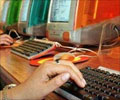
A team at Cornell University has made a breakthrough in that direction with a room-temperature magnetoelectric memory device. Equivalent to one computer bit, it exhibits the holy grail of next-generation nonvolatile memory: magnetic switchability, in two steps, with nothing but an electric field.
Researcher John Heron said that the advantage here is low energy consumption and it requires a low voltage, without current, to switch it. Devices that use currents consume more energy and dissipate a significant amount of that energy in the form of heat. That is what's heating up your computer and draining your batteries.
The researchers made their device out of a compound called bismuth ferrite, a favorite among materials mavens for a spectacularly rare trait: It's both magnetic like a fridge magnet, it has its own, permanent local magnetic field and also ferro-electric, meaning it's always electrically polarized, and that polarization can be switched by applying an electric field. Such so-called ferroic materials are typically one or the other, rarely both, as the mechanisms that drive the two phenomena usually fight each other.
This combination makes it a "multiferroic" material, a class of compounds that has enjoyed a buzz over the last decade or so and so bismuth ferrite can be used for nonvolatile memory devices with relatively simple geometries. The best part is it works at room temperature.
Their results are published online in Nature.
Advertisement










